ARM Announces Cortex-A72, CCI-500, and Mali-T880
by Andrei Frumusanu on February 3, 2015 5:30 PM EST- Posted in
- Smartphones
- Arm
- Mobile
- Mali
- Cortex A72
- CCI-500
- Mali T880

Today ARM is announcing three brand-new premium IP designs targeted at high-end mobile SoCs. We're still only starting to get widespread commercial availability of ARM's latest generation of SoCs, which includes the Cortex-A57 in big.LITTLE configuration coupled with the A53 as little cores, and the newest T760 Mali GPUs. But, while those designs are still ramping up through offerings from Samsung, Qualcomm, HiSilicon and co. this year, ARM isn't staying still and already looking forward to 2016 and beyond.
Cortex-A72 - a new high end core
At the center of today's announcements a new high-end performance core which succeeds the A57 in flagship devices. ARM was very vague about the architectural characteristics of the new design, disclosing for now only estimates of the chip's performance and power targets. ARM promises a 3.5x sustained performance increase over the A15 generation of SoCs while remaining in the same power budget. One has to note that we're talking about performance targets on TSMC's 16nm FinFET+ node versus previous nodes such as 28 and 20nm, which in itself should bring large clock and power advantages.
The A72 targets roughly 1.9X the sustained performance of current 20nm A57 SoCs, meaning the Exynos 5433 and the Snapdragon 810 can be taken as the base for comparisons. ARM doesn't yet mention peak performance so we may be talking about overall power efficiency gains that enable future SoCs to throttle much less. ARM will be divulging more information on the architecture of the A72 in the coming months, and we're hoping to have a better picture on the actual IPC and efficiency gains of the new flagship core by then.
The Cortex-A72, being a "big" core, can be partnered up with the already existing A53 LITTLE core architectures. ARM has said in the past that the A53 took in-order designs to new heights, and while work on a successor is underway, it seems that for now we'll be sticking with the A53 architecture for a while longer.
HiSilicon, MediaTek and Rockchip are listed among more than then launch partners which have already licensed the Cortex-A72 processor, so expect to see a variety of vendors offering the new ARM IP in 2016.
CoreLink CCI-500 SoC interconnect
It's been over 3 years since ARM initially announced their CCI-400 (Cache Coherent Interconnect), which saw widespread usage as the corner-stone technology enabling big.LITTLE heterogeneous multiprocessing in all consumer SoCs from the Exynos 5410 to the latest Snapdragon 810. While ARM also offered high-end alternatives such as the CCN-5XX (Cache Coherent Network) range of interconnects, these were targeted more at server-applications and not meant for mobile SoCs in smartphones or tablets.
The CCI-500 is a large upgrade over the CCI-400 as it introduces a variety of new functionality over its predecessor. The largest change in functionality is the addition of a snoop filter on the interconnect itself. Until now snoop control was only possible between CPUs within a single cluster. The addition of a snoop filter on the interconnect allows for power efficiency benefits as the amount of transactions when doing cache lookups is decreased, enabling both reduced overhead on the interconnect and also higher idle residency times on the CPU cores. This reduced overhead also frees up memory bandwidth on the interconnect, and ARM claims this enables for 30% better memory performance on the CPU ports.
The new interconnect also doubles up on its system bandwidth: We now have twice the number of ACE (AXI Coherency Extension) ports, enabling usage of a maximum of four CPU clusters (instead of the two that are possible with the CCI-400). We'll be continuing to see the usage of only two clusters in mobile designs, but the new IP gives licensees the flexibility to deviate according to their needs.
The increased bandwidth and numbers of ports on the interconnect also opens up the possibility of quad-channel memory controllers, resulting in 128-bit memory buses. The Snapdragon 805 was the first mobile product to feature such capability, although Qualcomm used a non-cache-coherent interconnect in their design.
Mali T880 GPU
Lastly, ARM also announced a new member of the T800 series of Mali GPUs. In addition to the T820, T830 and T860 comes the T880. ARM was again light on details of what this new configuration brings, only promising a 1.8x increase performance over 2014 Mali T760 GPUs and a 40% reduction in energy consumption for the same workloads.
With today's announcements, ARM appears to be addressing its weaknesses in mobile SoCs by focusing on sustained performance and efficiency of its big core architecture. We also have the much needed upgrade in the memory/interconnect subsystem and an expansion in its GPU IP offering.
Source: ARM


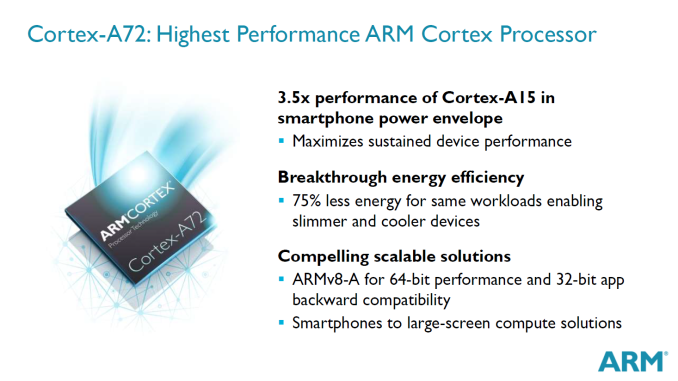
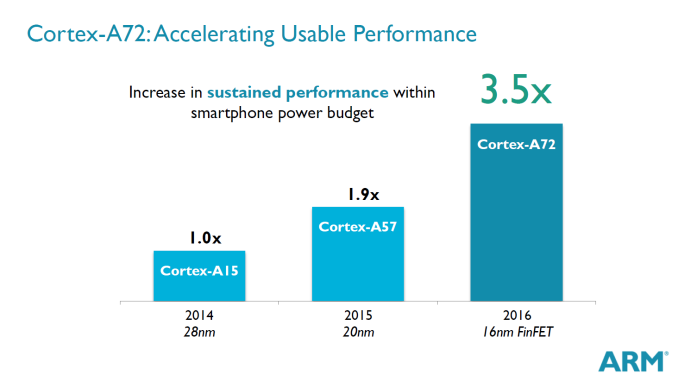
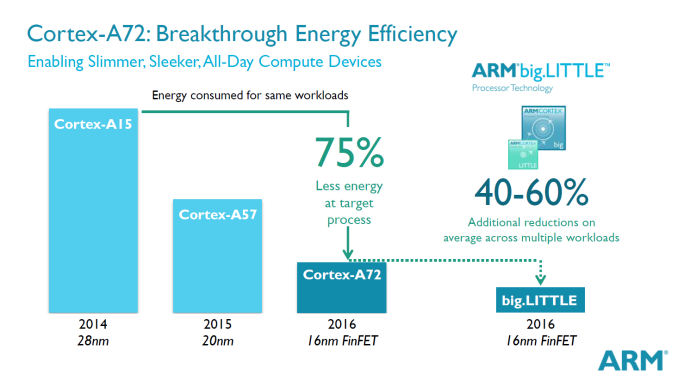
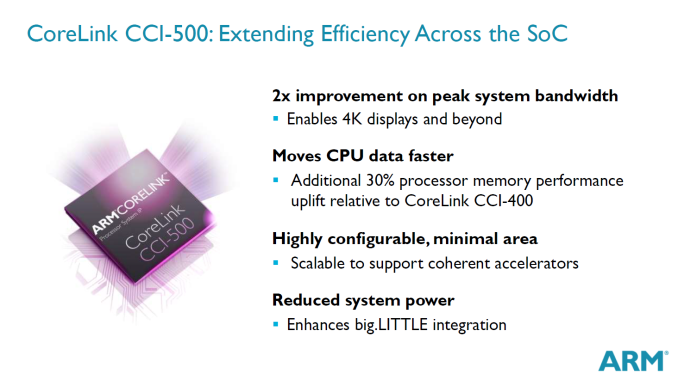
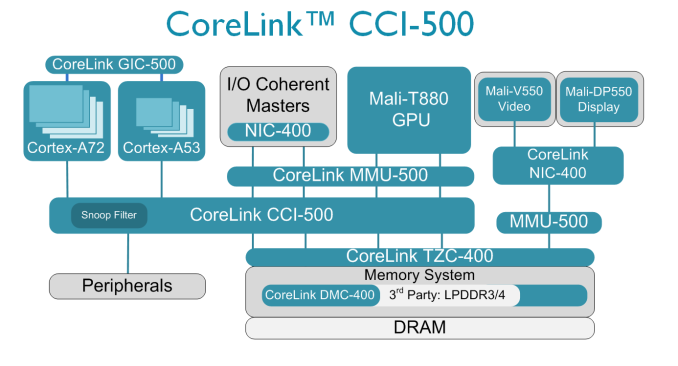
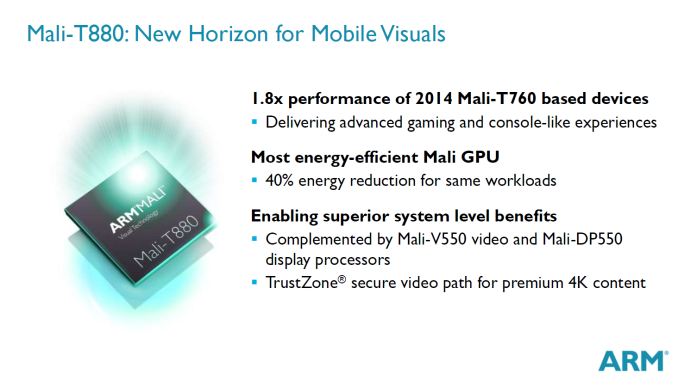








49 Comments
View All Comments
blanarahul - Tuesday, February 3, 2015 - link
Looks like big.LITTLE is here to stay. Oh well.Morawka - Tuesday, February 3, 2015 - link
If it were up to ARM, yeah every phone would use BIG.little. Because ARM makes more money per device. (They bill Clients per core) on cookie cutter implementations. IMO it's just a waste of precious board space, and it's a serious compromise due to their bigger cores using more power than everyone would like.at the most a system needs 2 little cores, but i'd argue one is enough. Fully custom ARM SoC's like apple's a8, are engineered around power efficiency at all workloads. When you can't make a custom SOC, you use these cookie cutter builds and pay out the ass in licensing cost.
levizx - Wednesday, February 4, 2015 - link
Yet Qualcomm opt for 4xA57+4xA53 and 2xA57+4xA53 design for their stop-gap solution. You would think if any of what you said were true, they would have 4xA57+2xA53 instead.SunLord - Wednesday, February 4, 2015 - link
If I'm not mistaken ARM's prefered optimal layout is 2xA57+4XA53 which I think was mention on this site in one of the talks with ARM SoC developersValantar - Wednesday, February 4, 2015 - link
Qualcomm, just like all other SoC manufacturers except apple, are "suffering" under the GIMME ALL THE CORES OMG OMG mentality of certain consumers (and thus also device manufacturers), especially driven by MediaTek and their early octa core chips (which "beat" Snapdragon 800 devices in ideal scenarios, but in reality performed ~half as well). Thus QC's stop-gap solution went octa-core to please mainly the asian market. Unfortunately, it seems like stupid solutions like this are here to stay. Apple's shown quite conclusively what can be done with a well designed dual core setup, which (in one core design!) scales from high performance (at low clocks, even), to very low power usage. Unfortunately nobody except Nvidia seems to have taken notice, and I very much doubt we'll se a Snapdragon 830/Exynos whatever/MTK ??? with an extra wide dual core design. Although I would buy the shit out of that.Jon Tseng - Wednesday, February 4, 2015 - link
> are "suffering" under the GIMME ALL THE CORES OMG OMGThe bizarro thing is that this is because "bao" (treasure) in Chinese sounds like "ba" (eight).
=> This means the number 8 is considered auspicious.
=> This means having 8 cores in your phone is highly prized.
So basically complex 21st century SoC architecture choices are being dictated by a linguistic coincidence!
Crazy...
simonsmithdh - Wednesday, February 4, 2015 - link
You may be talking about Mandarin, but in Cantonese ba sounds like fa (wealthy or properous). Do you have any evidence for your (plausible) assertion?hammer256 - Wednesday, February 18, 2015 - link
Yeah, the Cantonese theory is what I always heard. If I'm not mistaken, associating 8 with wealth is more of a southern tradition.skavi - Wednesday, February 4, 2015 - link
SunLord - Wednesday, February 4, 2015 - link
I like Hexa-core Socs but Octa seems pointles. I wonder if we'll ever see something like a 3xA57 and 3xA53 or a 1xA57 and 3xA53